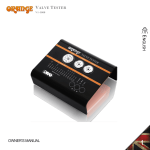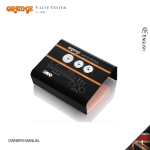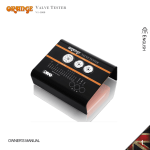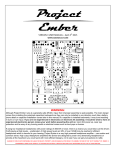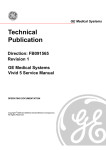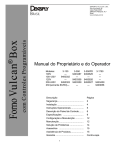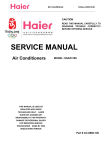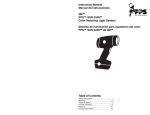Download Tenor 350M User Manual, November 2008
Transcript
Tenor 350M Mono Blocks Ultimate Reference Amplifier Owner’s Manual Te nor I nc. Version: November 2008 2 Important Safety Instructions • Please read this Owner’s Manual for your own safety and the protection of your Tenor equipment. • Once you have installed your Tenor equipment, store this Owner’s Manual in a safe place for future reference if necessary. • Please heed all warnings. • Please follow all instructions. • Do not use this equipment near water or where there might be a chance it could come in contact with water. • Clean only with a clean dry cloth. • Do not install near a heat source such as radiators, heat registers, stoves or any other source of heat. • Do not defeat the safety purpose of the polarized and/or grounding type plug. A polarized plug has two blades with one slightly wider than the other. A grounding plug includes the third ground prong. In the event the plug provided does not fit your power outlet, consult an electrician for assistance. Failure to do this may result in damage to the equipment and/or possible injury or death. • Please protect the power cord from being walked on or pinched, particularly at the wall and at the plug on the rear panel of the equipment. • The use of extension cords and/or convenience plugs is not advised due to the power requirements of the equipment. • Please mount equipment as specified in User Manual. • Please unplug equipment during lightening storms and when not in use for long periods of time. • Refer all service of equipment to qualified personnel. In the event the equipment has been damaged, dropped, exposed to water or foreign objects have entered the cabinet, disconnect immediately from power source and consult a qualified service technician. WARNING: TO REDUCE THE RISK OF FIRE OR ELECTRIC SHOCK, DO NOT EXPOSE THIS APPLIANCE TO RAIN OR MOISTURE! CAUTION: TO REDUCE THE RISK OF ELECTRICAL SHOCK, DO NOT REMOVE COVER. NO USER-SERVICEABLE PARTS INS IDE. REFER ALL SERVICING TO QUALIFIED PERSONNEL! 3 Table of Contents Introduction ........................................................................................................ 6 Congratulations....................................................................................................................................... 6 Safe Set-up Instructions .................................................................................................................... 6 Design Principles ................................................................................................................................... 6 Precision Engineering & Assembly ............................................................................................. 6 Unpacking............................................................................................................ 7 Lifting Caution – 148lbs (67Kg)!.....................................................................................................7 Travel Cases................................................................................................................................................7 List of Items Included with pair of Tenor 350M.................................................................7 Moving Amplifiers..................................................................................................................................7 Installation ......................................................................................................... 8 Considerations ..........................................................................................................................................8 3rd Party Isolation Stands ...................................................................................................................8 Placement....................................................................................................................................................8 Ventilation ..................................................................................................................................................8 Source Components .............................................................................................................................. 9 Speakers ....................................................................................................................................................... 9 Remote Turn On Jack.......................................................................................................................... 9 Power Requirements ........................................................................................ 10 AC Mains Voltage.................................................................................................................................. 10 Warm-Up ................................................................................................................................................... 10 Mute Operation ..................................................................................................................................... 10 Break-in Period.......................................................................................................................................11 Tube Life ....................................................................................................................................................11 Special Design Features .................................................................................. 12 Power Supply .......................................................................................................................................... 12 Audio Amplification..........................................................................................................................12 Protection .................................................................................................................................................12 Environmental Considerations .....................................................................................................13 4 Front Panel ....................................................................................................... 14 Front Panel Layout..............................................................................................................................14 On/Off Switch .......................................................................................................................................14 Front Lens – Indicator Light ...........................................................................................................15 Mute Switch .............................................................................................................................................15 Rear Panel & Internal View............................................................................. 16 Cautions .....................................................................................................................................................16 AC Mains On/Off & Fuse .................................................................................................................16 Remote Turn On Jack........................................................................................................................16 Single Ended and Balanced Inputs............................................................................................ 17 Loudspeaker Binding Posts ............................................................................................................ 17 350M Internal View ............................................................................................................................. 17 Troubleshooting & Protection Circuitry Overview........................................ 18 Internal Fuses Associated With Protection Circuitry................................................... 18 Other Internal Fuses........................................................................................................................... 18 Example Protection Scenarios ..................................................................................................... 19 No Audio + Front Panel Lens Light is Dark .................................................................... 19 No Audio + Front Panel Lens Light is Blue..................................................................... 19 No Audio + Front Panel Lens Light is Red (continuous) ........................................ 19 No Audio + Front Panel Lens Light is Red (flashing)...............................................20 Audio + Front Panel Lens Light turns briefly from Blue (normal) to Red 20 Ground Hum............................................................................................................................................20 Care and Maintenance ..................................................................................... 21 Wood Faceplate and Top Rails .................................................................................................... 21 Metal Chassis and Top Plate......................................................................................................... 21 Electrical Connections on Rear Plate......................................................................................21 Audio Board (Vacuum Tubes)....................................................................................................... 21 Tenor 350M Specifications ..............................................................................22 Warranty ........................................................................................................... 23 Product Registration ....................................................................................... 24 Tenor Contact Information.............................................................................. 25 Owner’s Notes.................................................................................................. 26 5 Introduction Congratulations Congratulations on the purchase of your new Tenor 350M Mono Blocks (Tenor 350M) Ultimate Reference Amplifier. We are very proud of the extensive engineering, design and craftsmanship in our amplifiers and are confident that our Tenor 350M will deliver the musical experience of your lifetime. Safe Set-up Instructions This Owner’s Manual is provided to assist in the unpacking, installation and ongoing care of your Tenor 350M amplifier. It is recommended that you take a few minutes to acquaint yourself with the contents of this manual before you unpack further so that you are safe and the amplifier is handled correctly. Design Principles The passion and desire to attain the most realistic and live musical reproduction has been a lifetime goal of Tenor. Building on our classics, the internationally acclaimed Tenor OTL (Output Transformer-Less) and Tenor 300 Hybrid, the new Tenor 350M Ultimate Reference Amplifier delivers musicality and transparency beyond any other known amplifier. Tenor’s proprietary research in the field of harmonic structural integrity is the essence behind the transparency and resolution of the Tenor 350M Ultimate Reference Amplifier. It is our opinion, as is many industry experts, the Tenor 350M is the finest amplifier ever made. Period! Precision Engineering & Assembly Each Tenor amplifier is custom manufactured in Montreal, Canada by master technicians dedicated to exacting standards. Rigorous testing and component matching is conducted on all amplifier components prior to assembly. Once assembled, each amplifier is rigorously tested for several hundred hours to ensure complete equilibrium prior to its ultimate calibration. Finally, the Tenor 350M is securely packed in its own custom travel cases for transport to the new owner. 6 Unpacking Every Tenor Amplifier is carefully fitted for transit into its own custom travel case. Given the weight and size of each amplifier, it is suggested that careful attention be given to the following: Lifting Caution – 148lbs (67Kg)! Each amplifier and carrying case has a combined weight of 148 lbs (67kg). One must exercise extreme caution when lifting and moving an amplifier. It is suggested that 2 people unpack and position each amplifier for optimum placement in your system. Travel Cases The travel cases have been custom designed to provide the ultimate protection during transit and storage of the amplifiers. Each empty case weighs approximately 30 lbs. They should be stored away in a safe and dry location when not in use. Given that you have opened the lids of the travel case to access this manual, please set them aside while you position your amplifier for installation in your system. Each amplifier weighs 118 lbs (54kg) and has a heavy transformer located towards the rear. The balance point of the amplifier is not at the centre of as one might assume but actually about 2/3 towards the rear creating an awkward load if lifted in the centre. Caution should be used in lifting the amplifier upwards out of the lower portion of the travel case to make sure that nothing scratches the beautiful Tenor finish. It is recommended that the travel case and amplifier be positioned close to its final location using the wheels of the travel case if necessary. Ideally 2 reasonably strong people should lift the amplifier upwards from the travel case until the amplifier is completely clear of the sides of the travel case and positioned carefully in its final location for connection to your music system. List of Items Included with pair of Tenor 350M • • • • 1 Owners Manual per Pair of Amplifiers 2 Power Cords - 1 In Each Travel Case 1 Hex Key per Pair of Amplifiers Package of User Accessible Fuses (2 - 15 Amp Mains) Moving Amplifiers Each amplifier weighs 118 lbs (54kg) and has the center of its weight located roughly 2/3 towards the rear of the amplifier making it very challenging for 1 person to move comfortably. The feet of the amplifier have rubber contacts that make it difficult to slide on carpet or hard surfaces so it is always recommended that the amplifier be lifted rather than dragged when moving. It is also suggested that 2 people lift the amplifier from one location to another. If moving the amplifier with one person, place your hands 2/3 towards the back and underneath each side. To protect the beautiful metal and word-work, it is always recommended to use the travel cases when relocating. 7 Installation Considerations The Tenor amplifier needs to be located in a clean, safe and dry environment within close proximity to AC power mains. Placement on the floor close to your speakers is an ideal location as long as the amplifier is not in people’s way. Always consider that a visitor not familiar with your room may stumble upon them if they obstruct normal pedestrian passage particularly if the lighting is low which is often the case in a listening room. 3rd Party Isolation Stands Mechanical isolation of the Tenor 350M is excellent so 3rd party isolation stands are not mandatory. If 3rd party isolation stands are to be used, please ensure that their specifications support an amplifier weighing 118 lbs (54kg) and the 2/3 : 1/3 weight distribution towards the rear is taken into consideration in the design. Placement AC power mains should be within reasonable access and although both left and right amplifiers can be installed on one 15 amp circuit @ 120 Volts (8 Amps @ 240 Volts) the full dynamic headroom potential of the Tenor 350M amplifiers will only be achieved with a dedicated circuit for each amplifier. The efficiency of your speakers and the size of your room play a large factor in the current draw necessary to recreate the recorded musical event to realistic and enjoyable levels. Ventilation Ventilation of the Tenor amplifier occurs by convection without the need for electric cooling fans. Vents in the bottom of the chassis and top cover plate allow sufficient cooling under normal operating conditions. It is imperative that these vents be kept clean and unobstructed. Please note, the two amplifier chassis should never be stacked one on top of the other! It is normal for the top cover panel to get a warm over the tube audio board located towards the front of the chassis. It is necessary to keep this top cover installed and completely clear at all times to ensure maximum ventilation allowing the proper uniform cooling of internal components. The heat sinks located on each side of the amplifier provide cooling for the mosfet output devices. The heat sinks run reasonably cool as long as they are kept clean and unobstructed. Special Note: Operating the amplifier in the bottom half of the travel case will block the lower air intake vents which could result in overheating and will void the Warranty if damage occurs. Failure to keep the top plate clear resulting in overheating will void the Warranty. 8 Source Components The transparency and gain of the Tenor 350M amplifier requires your source components to be of a sufficient high quality. Any imperfections at the source will most definitely be noticeable. In practice, Tenor amplifiers allow most source components to sound their best; nevertheless, the ultimate in sound reproduction is only achieved with the use of the finest digital and/or analogue audio source equipment and cables. Either single ended RCA or balanced XLR inputs can be used. Sufficiently long cables allow the convenient location of the source equipment away from the amplifiers and in close proximity to the user. It is our recommendation that single ended cables be used unless interconnects exceed 50 feet or 15 metres whereby external noise may be induced - then it is recommend to use balanced interconnects. Generally all source equipment can be powered using a single Mains circuit thereby minimizing the possibility of ground loop hum. It is recommended that this be a separate circuit from the amplifiers but have the same overall grounding Speakers The Tenor 350M is capable of driving virtually any speaker with an average impedance of 4 to 16 Ohms and capable of handling 350 watts continuous power. The impressive Tenor 350M dynamic headroom necessitates speakers that can handle this power (see Tenor 350M Specifications) or you will risk damaging your speakers. The re-creation of the musical event in a realistic manner requires substantial current. Your speakers can be easily damaged if they are not capable of handling this level of power. Although Tenor has very effective protection circuitry, it is still possible to overdrive your speakers and as such Tenor is not responsible for any speaker damage. Speakers should be connected with respect for polarity whereby the positive (+) or red output is attached to the same of the speaker. Similarly the negative (-) or white should be attached to the negative (-) or black of the speaker. Remote Turn On Jack Providing continuous 12 volts DC to the “Remote Turn On Jack” via a mini phone plug will automatically turn the amplifier on similar to the front rocker switch located slightly off centre at the front and just under the wood face plate. This will only work if the main power switch on the back panel is in the “on” position. Similarly, providing no voltage will cause the amplifier to turn off. This feature allows the amplifier to be turned on via a 12 volt trigger provided by an audio/video preamplifier as an example. Please be mindful of the volume level of the preamplifier when the amplifier come “on line” after the standard warm-up time of 3 minutes. Failure to do so could cause amplifier and speaker damage which would not be covered by the Tenor Warranty. 9 Power Requirements AC Mains Voltage Tenor amplifiers can be powered using conventional power company voltages ranging from 100 Volts to 250 Volts at either 50 or 60 Hz. The voltage for your application must be specified at the time of ordering so the transformer can be configured accordingly and the correct AC mains cable can be supplied. The use of power conditioners on the AC power mains feeding the Tenor 350M amplifier is not recommended due to the current limiting effect of most power conditioners. 20 amp circuits at 100 - 120 Volts and 10 amp circuits at 220-250 Volts provide the ultimate source of power for maximum dynamic headroom of the Tenor 350M but would require custom cables not provided by Tenor. Appropriate regional Electrical Codes and Professionals should be consulted regarding any custom electrical configuration beyond the regular domestic wiring of your installation. Warm-Up The master Mains Power switch of your Tenor 350M amplifier is located at the top right of the rear panel - when looking at the amplifier from the front. This engages the power rocker switch on the front underside of the chassis just behind and below the front panel. When pushed to the “on” position, this switch operates the relays providing power to the Tenor 350M. The lens in the front panel will glow red identifying the Tenor 350M is now in “mute” for the 3-minute warm-up and stabilization period. Once 3-minutes has expired the Tenor 350M is now warmed and stabilized so the lens will then change from red to blue showing the amplifier is now on line and ready for use. It will take up to 60 minutes for the 350M to reach optimum operating temperature. Mute Operation Mute operation is achieved by pushing the round centre button located on the underneath of the chassis just behind the front panel and to the left of the secondary power switch. The muting function shorts the inputs and removes the DC offsets and power to the speaker terminals. Mute is not a “standby” in the traditional Instrument or PA Amplifier sense as the Tenor 350M is fully powered but simply muted. It is not advisable to leave the amplifier in “mute” when not in use as the tube life will be diminished considerably. The amplifier is designed to provide near full potential immediately following the 3-minute warm-up and stabilization period following power up. Maximum dynamic headroom and transparency is achieved following about 60 minutes of playing operation. 10 Break-in Period Components of the Tenor 350M are broken-in prior to assembly for a period up to 200 hours. Following assembly, each amplifier is burned-in at the Tenor factory for a period of no less than 100 hours allowing each electronic component to stabilize and achieve its optimum electrical and musical potential as a system. Each amplifier is then calibrated to the factory specification and is designed to remain within tolerance for a period up to 10 years or more depending on use and care. Tube Life The Tenor 350M is designed to operate within design specifications for a period close to 10,000 hours. As a typical example, a Tenor 350M used each and every day for 3 hours under normal use will last almost 10 years before it will need a tube refit and calibration. A meter is located on the back panel showing the hours of enjoyment this amplifier has delivered and will be shipped from the factory reading “zero” hours. Most owners will experience a lifetime of listening pleasure without ever reaching the 10,000 hour maximum. When the 10,000 hours of use has been achieved, the amplifier should be returned to the factory for re-tubing and calibration. 11 Special Design Features Power Supply The heart of the power supply for the Tenor 350M is a custom designed and manufactured high current transformer that accommodates various international voltages and frequencies in providing specific line voltages for each stage of the amplification process. The Tenor 350M Mains voltage must be specified when ordered to match the voltage and frequency provided by your local power company. This also determines the proper cable to be shipped with the amplifiers. Audio Amplification The Tenor 350M combines the voltage output of tubes with the high current output of mosfet transistors in an ingenious Tenor hybrid design. By leveraging the best of each technology in a unique proprietary design, the Tenor 350M is the ultimate in resolution and transparency in a dual chassis mono block design. The first stage of the 350M design is based on the original all tube OTL (Output Transformer-Less) proprietary concept pioneered by Tenor in the late 1990’s. This all tube stage provides 10 watts per channel of pure Class A voltage at a relatively high impedance (by speaker standards) which is ideal input for a bank of mosfet transistors. The second stage of the 350M circuitry processes this voltage rich 10 watts per channel and provides additional current to increase the power to 350 watts per channel @ 8 ohms (at the speaker terminals). The sonic beauty of the tube with the massive power of the mosfet is optimized in a unique proprietary Tenor design for an audio presentation that is simply breathtaking! Protection Tenor amplifiers have a sophisticated monitoring and protection circuitry that allows the amplifier to operate at peak musical potential while continuously monitoring a number of conditions that could harm the amplifier or attached equipment – all without interfering with the audio signal! The 6 main conditions being monitored are as follows: 1. 2. 3. 4. 5. 6. Low AC main voltage DC offset at speaker terminals AC at speaker terminals Static discharge Ground pollution RF (Radio Frequency) levels If any of the above conditions exceed prescribed levels, the amplifier will automatically protect itself by “muting”. The front panel lens will change from blue to red when this occurs. “Muting” achieves the following: • Shorts the RCA and Balanced XLR inputs through a resister to ground • Removes the bias to the output transistors 12 This effectively removes all DC offsets and AC current to the speaker terminals. In the event that the offending condition has been removed or corrected, the amplifier will return to an “on line” status whereby the lens light will now be blue and the amplifier will function as normal. Should the fault or condition not be removed, the amplifier will cycle between red and blue in 1-second intervals until the fault disappears or the amplifier is powered off by the operator and the condition is remedied. An internal jumper switch can be set to require a manual reset which keeps the amplifier in “mute” after a fault condition which can only be returned to “on line” status by the operator selecting the mute button under the front panel. If the amplifier fault has not been cleared, it will immediately return to the muted state and the lens will continue to be red. Environmental Considerations Considerable effort went into the efficiency of the Tenor 350M and its power consumption. To maximize the efficiency of the amplifier and to minimize its “carbon foot print”, Tenor undertook a yearlong project to design and test various transformer designs. Adhering to close tolerances and state of the art materials, the new 350M consumes 20% less energy, dissipates less heat and simply sounds better than standard transformers! 13 Front Panel Front Panel Layout The front panel of the Tenor 350M amplifier is made from the finest select cherry wood. It has been hand finished with 10 coats of clear piano lacquer. Over time the cherry wood will age by showing a somewhat mellow patina making the amplifier more beautiful. The same is also true of the decorative cherry rails on top of the amplifier. On/Off Switch There are 2 on/off switches on the Tenor 350M amplifier. If the rear master switch is in the on position, one can power the amplifier on and off using the secondary rocker switch located below the front panel slightly to the right of center. If the rear master switch is in the off position, the front switch will not function. 14 Front Lens – Indicator Light The lens on the front panel is an indicator light that is dark (i.e. not lit), red or blue and, in the event of a fault, blue will change to red in 1-second increments. Dark means that the amplifier is either not on or there is no power provided to the amplifier. Red indicates that the amplifier is in “mute” indicating that: 1. It is warming up after an initial power-up, or 2. It has been muted manually, or 3. A fault condition exists that caused the amplifier to “mute” (given the inside jumper is set to manual). More specific details on this are provided in the “Protection” section under “Special Design Features” in this manual. The lens turning from red to blue in 1-second increments means the inside jumper is set to “automatic” and the amplifier is attempting to clear the problem and return to a normal “on-line” state. If the fault condition is not corrected and the amplifier continues to cycle between red and blue, it is recommended that the amplifier be turned off until the condition can be identified and corrected properly. Mute Switch The mute switch is located below the front panel on the underside of the chassis. Please refer to “Mute Operation” under “Power Requirements” to better understand the operation of this switch and its role in the protection circuitry. 15 Rear Panel & Internal View Cautions AC Mains On/Off & Fuse Remote Turn On Jack 16 Single Ended and Balanced Inputs Loudspeaker Binding Posts 350M Internal View 17 Troubleshooting & Protection Circuitry Overview Internal Fuses Associated With Protection Circuitry There are 6 internal fuses associated with the protection circuitry as follows: 1. 2. 3. 4. 5. 6. 7 Amps FB (314) @ +85 volt fuse to left Rib (F1) 7 Amps FB (314) @ -85 volt fuse to left Rib (F2) 7 Amps FB (314) @ +85 volt fuse to right Rib (F1) 7 Amps FB (314) @ -85 volt fuse on right Rib (F2) 200 milliAmps SB, (TR5) @ +125 volt fuse to Power Supply Board (F3) 200 milliAmps SB (TR5) @ –125 volt fuse to Power Supply Board (F4) Please Note: None of these fuses are user replaceable – all require Tenor Service! During the initial 3-minutes warm-up, the amplifier will monitor the above fuses as well as the temperature of the heat sinks. In the event that a fuse is blown and/or the heat sink is over 75C, the amplifier lens will flash red in 1-second increments. Each rib fuse has a red LED (Light Emitting Diode) that identifies it has blown which makes identification very straightforward. If all conditions are met, the amplifier will un-mute or go “on-line” after 3-minutes when the jumper is set on automatic. If the jumper is set to manual, after 3-minutes has passed you can press the mute button to go “on-line” again. Other Internal Fuses There are 5 other fuses as follows: 1. 2. 3. 4. 5. 2 Amps SB (TR5) @ 12.8 Volts DC heater voltage (F1) 15 Amps SB (218) @ 6.6 Volts DC heater voltage (F2) 200 milliAmps FB (TR5) @ +285 Volts DC for Audio Board (F5) 200 milliAmps FB (TR5) @ –285 Volts DC for Audio Board (F6) 15 Amps SB (MDA) for 120 Volts or 8 Amps SB (MDA) for 240 Volts for Mains fuse on rear panel Please Note: Only fuse 5., the Mains fuse, is user replaceable - all others require Tenor Service! 18 Example Protection Scenarios No Audio + Front Panel Lens Light is Dark The simplest condition for no audio is the amplifier is simply not getting power and perhaps not plugged into the AC mains. This should be verified before pursuing any further remedy. If power is provided correctly to the amplifier, the following 5 conditions must be met before the amplifier will proceed to the 3-minute warm-up as follows: 1. Fuse on Relay Board ok 2. Left Rib temperature less than 80C 3. Right Rib temperature less than 80C 4. Transformer temperature less than 120C 5. Mains Fuse ok If there is no red lens light on but the red light on the rear switch is on then condition 2, 3, 4 or 5 need to be addressed. If the there is no front red lens light on as well as no red light on rear switch then fuse on 1 needs to be addressed. Conditions 2, 3 and 4 can be remedied by simply allowing the amplifier to cool down by powering off for a sufficient period of time. Failure of condition 1 requires Tenor Service! No Audio + Front Panel Lens Light is Blue When there is no audio and the front panel lens light is blue suggests that the input, RCA or Balanced XLR and/or the speaker cables are not connected properly. Please power off the amplifier and examine these connections. Please take particular note of the input toggle on the rear panel to select between RCA and XLR - as it may be opposite to what you intended. No Audio + Front Panel Lens Light is Red (continuous) When there is no audio and the front panel lens light is red suggests that your amplifier has encountered a fault and is now in “mute”. The 6 conditions being monitored are: 1. Low AC main voltage 2. DC offset at speaker terminals 3. AC at speaker terminals 4. Static discharge 5. Ground pollution 6. RF (Radio Frequency) levels If the internal protection jumper is set to automatic, the amplifier will return to Blue after a 3-minute interval if the condition has corrected itself. If the jumper is set to manual, the amplifier will require you to press the mute button to return to “on line” status after 3-minutes. 19 No Audio + Front Panel Lens Light is Red (flashing) During the 3-minute warm-up, the amplifier monitors the 7 following conditions: 1. 2. 3. 4. 5. 6. 7. +80 Volts on left Rib (F1) –80 Volts on left Rib (F2) +80 Volts on right Rib (F1) –80 Volts on right Rib (F2) +125 Volts on front Power Supply Board (F3) –125 Volts on front Power Supply Board (F4) Heat Sink temperature less than 75C If any condition from 1 – 6 and/or 7are not met, then the front panel lens light will flash red. The fuses on 1 – 6 are identified under “Troubleshooting” and will have a red LED (Light Emitting Diode) if they are blown. The amplifier will return “on line” automatically (or can be manually “un-muted” after 3-minutes) if all conditions have been cleared. Audio + Front Panel Lens Light turns briefly from Blue (normal) to Red On very loud musical passages the current draw from the AC mains available at the wall could be lowered to 110 Volts when ideally it should be 125 Volts or 220 Volts when it ideally should be 240 Volts - thereby creating a DC offset in excess of 130 mV causing the amplifier to “mute” and turn the lens light red. 1-second later the loud passage is over and the amplifier is now receiving proper voltage and plays normally again thereby returning to blue. It may be possible to reconfigure your AC wiring to provide better current if this should happen but you should always consult local Electrical Codes and seek Professional assistance. Ground Hum Ground hum can occur for a number of reasons but it generally occurs when there is a difference in ground potential between one or more components in the audio chain as a result of components plugged into different power mains that have different grounding. Ideally for the best sound each 350M chassis should be plugged into individual circuits and all other components should be plugged into a separate circuit but this also has the greatest potential for ground hum. In the event that ground hum exists, each 350M chassis, through the switches shown at the right, has the ability to be grounded directly, grounded through a resistor or the ground is “lifted” entirely. Experimentation will prove what selection is best and it may be different for each amplifier. So do not concern one self if one chassis’ Audio Ground switch is different than the other 350M for the best results. 20 Care and Maintenance Wood Faceplate and Top Rails The hand lacquered Wood Faceplate and Top Rails require very little maintenance. Should they become marked with fingerprints, a polish used for fine furniture can be used but only if applied to a soft cloth and then rubbed on the wood. Spraying polish directly on the wood may contaminate the electrical components inside and could void your Warranty. Keep out of direct sunlight if at all possible. Metal Chassis and Top Plate The Metal Chassis and Top Plate need very little care other than dusting from time to time. Do not use spray wax or dusting liquid as it may contaminate the electrical components inside and could void your Warranty. Dusting with a soft brush is recommended. Electrical Connections on Rear Plate From time to time it is good to disconnect and reconnect your cables at the rear to improve any degradation due to normal electrical oxidization. Make sure your amplifier is turned off and that you disconnect then reconnect each connecter one at a time to avoid any mix up. Audio Board (Vacuum Tubes) The Audio Board is home to all of the Vacuum Tubes in the Tenor 350M. Every tube is matched and calibrated in the circuit so unless you are specifically directed by Tenor to alter these tubes they should never be touched except by trained Tenor service technicians. Each tube has been selected for its optimum electrical characteristics and the entire circuit has been calibrated for these specific tubes. Any alteration of the tubes may cause the Tenor 350M to be out of specification and any failure as a result would not be covered by Warranty. 21 Tenor 350M Specifications Amplifier type ....................................................... Mono Power amplifier Voltage gain........................................................... 32 dB Unbal. / 30 dB Bal. Rated power: 2, 4, 8Ω, 1kHz, 120 VAC* ......................... 1400, 700, 350 W S/N Ratio reference to 10 W* ...................................... -94 dBA S/N Ratio reference to rated output* ............................ -115 dBA Frequency response................................................. 3 to 200 000 Hz ± 3dB THD + N @ 5 W 20-20K............................................ < 0.05% THD + N @ 10 W .................................................... < 0.04%* THD + N @ 350 W ................................................... < 0.17%* IMD S MPTE @ 10W – 100W ........................................ < .01% - < 0.02% Maximum output current, 1kHz, 2 Ohm ....................... 40A peak Input impedance 1kHz Bal. / Unbal. ............................ 20 KΩ / 33KΩ Output impedance* ................................................. 0.08 Ω Damping factor* ..................................................... 100 Output DC offset .................................................... less than 1.0 mv DC Rise time .............................................................. 1.15 µs @ 10 KHz Pure class A power ................................................. 13W * Input sensitivity for 350 W, 8Ω, 1kHz ........................... 1.3 V Bal. / 1.5 V Unbal. Global negative feedback .......................................... Zero Main dual core power transformer............................... 1.875 KVA Balanced input pin configuration ................................ 1: Gnd., 2: Pos., 3: Neg. Input tubes ........................................................... 2 x ECC803S, 1 x ECC99 , 6 x 7044 Soft start ............................................................. 3-minute Remote turn on ...................................................... 3 to 30 VDC, 1/8” connector Cooling ................................................................. Natural convection Micro phonic isolation.............................................. Fully suspended audio board Binding post .......................................................... 2 sets WBT Fuses ................................................................... 11 Protection against ** ................................................ heat, dc offset, current, static, RF, .......................................................................... ground pollution, short circuit Maximum power consumption ................................... 1850 W @ 120V, 60 Hz Idle power consumption ........................................... 280 W @ 120V, 60 Hz Supply voltage factory set ......................................... 100 to 250VAC, 50 / 60 Hz. AC mains input ...................................................... 20A IEC detachable power cord Weight per unit ...................................................... 118 lbs / 53.5 kg Shipping weight in custom road case ........................... 148 lbs / 67.2 kg Dimensions ........................................................... 19.5” W x 28” D x 9.5” H * : @ 8 Ohm, 1kHz **: Outside signal path Tenor Inc. reserves the right to make improvements which may result in specification changes without notice May 2008 22 Warranty Tenor Inc. Canada warrants the Tenor 350M to be free from defects in materials or workmanship for a period of 5 years from the date of the original purchase provided the amplifier is registered with Tenor Inc. Canada within 90 days of the purchase date and there is valid proof of purchase from an authorized Tenor Inc. dealer or distributor. Following the receipt of your registration and upon successful validation that your amplifier has been purchased from an authorized Tenor Inc. dealer or distributor, you will receive a custom plate for mounting on the back of each amplifier which shows the amplifier has been purchased from an authorized dealer or distributor and has been custom made for you. This plate must be affixed to the back of the amplifier for the warranty to be valid. Any amplifier returned to Tenor Inc. without this custom plate affixed will have its Warranty revoked. Vacuum tubes are guaranteed for 10,000 hours or 5 years from the original purchase date - whichever comes first. Should the Tenor 350M be defective during the 5 year Warranty period, Tenor Inc. elects at its sole discretion to either repair or replace the unit free of charge. Prior Authorization and a Return Authorization Number (RAN) are mandatory for Tenor Inc. to undertake any service under the aforementioned Warranty. Transportation costs and insurance costs for shipment to Tenor Inc.’s Canadian Service Facility for Warranty repair are the responsibility of the owner. Transportation costs and insurance from the Canadian repair facility to the owner will be the responsibility of Tenor Inc. and the shipment method will be ground/sea or equivalent unless the owner agrees to pay the surcharge associated with an expedited method of transportation. The use of Vacuum tubes not supplied by Tenor Inc. will void the Warranty. Attempting to repair or modify Tenor 350M amplifier will void the Warranty. Missing or altered serial numbers automatically void the Warranty. 23 Product Registration To ensure your amplifier is covered by the Tenor Inc. 5 year warranty, it is mandatory that you register with Tenor Inc. by mail or email within 90 days of purchase and provide us with all of the following information: Model Number: ___________________________________________ Serial Number of each 350M: ________________________________ Date of Purchase: _________________________________________ Dealer and/or Distributor’s Trade Name & Contact Name: ________________________________________________________ Dealer and/or Distributor’s Phone Number: ___________________ Dealer and/or Distributor’s Email Address: ___________________ Dealer and/or Distributor’s Address: _________________________________________________________ _________________________________________________________ _________________________________________________________ _________________________________________________________ Your Name (will be engraved on custom plate): _________________________________________________________ Your Phone Number: _______________________________________ Your Email Address: _______________________________________ Your Address: _________________________________________________________ _________________________________________________________ _________________________________________________________ _________________________________________________________ Failure to provide any of the above information will void your warranty registration. 24 Tenor Contact Information Before returning your amplifier to Tenor Inc., it is necessary to receive a Return Authorization Number (RAN) as stated in Warranty Conditions. A RAN will be issed by contacting Tenor Inc. and describing the nature of your service request using either email or phone as follows: Tenor Inc. Service Email: [email protected] Tenor Inc. Service Phone Number: 514 933-6035 Once you have received a RAN, you can ship your amplifiers to the following address with the RAN marked clearly on the outside of the shipping cases (Please note that shipping costs and insurance are the responsibility of the shipper): Tenor Inc. 1001 Lenoir, Suite A-209 Montreal, PQ, H4C 2Z6 Phone Number is 514 933-6035 Fax Number is 514 933-3177 Other contact information is as follows: Web Site is: www.tenoraudio.com Sales Email: [email protected] 25 Owner’s Notes 26






























